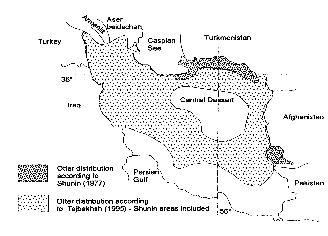|
IUCN/SCC Otter Specialist Group Bulletin
©IUCN/SCC Otter Specialist Group
Volume 13 Issue 1 Pages 1 - 55 (October 1996)
Citation: Gutleb, B., Rautschka, R. and Gutleb, A.C. (1996). Some Comments on the Otter (Lutra lutra) in Iran. IUCN
Otter Spec. Group Bull. 13 (1): 43 - 44
Previous
| Contents |
Next
Some Comments on the Otter (Lutra lutra) in Iran
Bernhard Gutleb1
, Rudolf Rautschka2
and Arno Christian Gutleb2
1Verein für Wildtierforschung - Wildlife Management International Service, POB 1, A - 9545 Radenthein, Austria
2University of Veterinary Medicine Vienna, Institute of Medical Chemistry, Josef-Baumann-Gasse 1, A-1210 Vienna, Austria
|
|
Abstract: Little is known about otters in Iran. OF the existing publications based on hunting data, one considres otters are only in the northeast and a nature reserve on the Afghanistan border, and the other considers that otters are widespread throughout all but the central desert and fringes of the Persian Gulf. Smooth coated otters may also be present, which hunters may not distinguish from Eurasian otters. A forthcoming set of expeditions should clarify the position.
|
Like for a lot of other mammal species (for example brown bear,
Servheen, 1990
) the present status of the Eurasian otter (Lutra lutra) in Iran is fairly unknown (
Foster-Turley et al., 1990
). The “Verein für Wildtierforschung - Wildlife Management International Service” is organizing scientific excursions to Iran, the 16th biggest country in the world with tremendous natural resources from 180.000 km² forested area to arid and semiarid ecosystems. During the preparation of the two next excursions to the south (February 1997) and the north (September 1998) of Iran data of the distribution of mammals became available and will be completed by personal contacts to scientists in the country and field work during the forthcoming excursions.
According to the book “Hunting in Iran - from the beginning until today” (
Tajbakhsh, 1995
) the otter can be found “in most rivers and lakes of most provinces of Iran” (
Fig.1
). It is not proved that this very general statement is correct due to the size of the area, but in principle it should give a realistic view to the distribution in connection with hunting statistics and the presence of river systems.
Ishunin (1977)
gave some regional data of otter presence in North and Eastern Iran. According to his publication otters can be found in the Hamoon Wetland, a Nature Reserve in the south of the border area to Afghanistan, and its effluent rivers Farah-Rud and Rud-e-Helmand. In the North otters can be found in clear and small rivers in the mountain range Koppe-Dagh, the border area to Turkmenistan and its main river to the Caspian See Rud-e-Atrak. In the Alburz mountain the otter is known to occur in the river Tadjan in the south of the town Sari but should be more common due to the presence of many rivers.
There seems to be a possibility for the existence of unknown populations of the smooth coated otter (Lutra perspicillata) in Iran, as this species is known to be fairly common in Pakistan and to occur in Iraq (
Foster-Turley et al., 1990
). Local hunters might have problems to distinguish between the Eurasian otter and the smooth coated otter. It is hoped that the two forthcoming excursions will lead to more information on the status and distribution of otter species in Iran.
REFERENCES
Foster-Turley, P., Macdonald, S.M., Mason, C.F. 1990. Otters. An action plan for their conservation. IUCN, Gland
Ishunin, G.I. 1977. Distribution and numbers of the Persian otter. Rare and endangered mammals and birds of the Kazakhstan, Alma Ata
Servheen, C. 1990. The Status and Conservation of the Bears of the World. Conf. of Bear Res. and Manage, Monogr. Series No.2, 32 pp.
Tajbakhsh, H. (1995): Hunting in Iran - from the beginning until today. The Museum of Natural Traditions and Wildlife of Iran, Tehran. 238 pp.
Previous
|
Contents
|
Next
|

